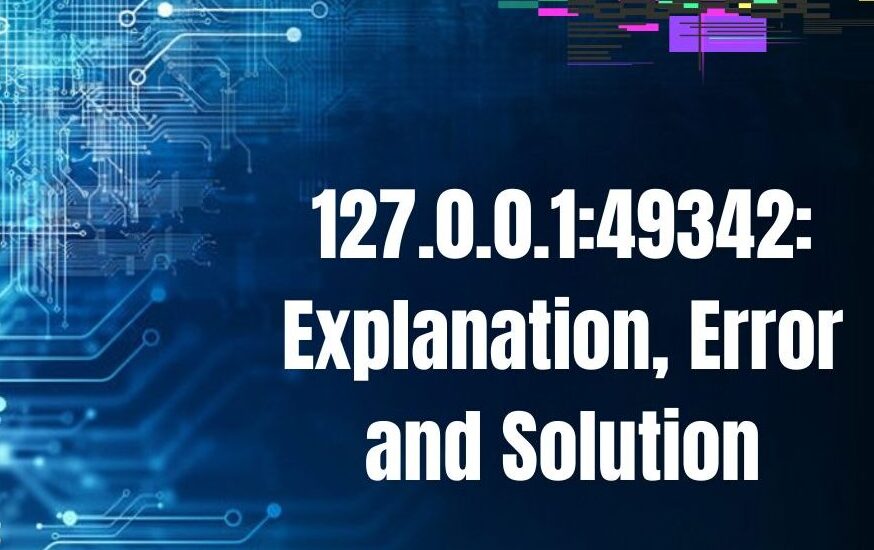Introduction
Encountering the “127.0.0.1:49342” error can be frustrating, especially when you’re unsure how to fix it. This connection issue is common for users across the globe, and while it may seem cryptic, resolving it is simpler than you think. In this guide, we will break down the causes of this error and provide step-by-step solutions to get your system back up and running smoothly.
What Does the 127.0.0.1:49342 Error Mean?
Before diving into solutions, let’s understand the error. The address 127.0.0.1 is known as “localhost,” which refers to your own computer. It’s a loopback address that allows your computer to communicate with itself. The :49342 part refers to the port number, which is used to specify different programs’ communication paths. Together, 127.0.0.1:49342 indicates that something on your system is trying to access this particular port but is encountering issues.
Why Does the 127.0.0.1:49342 Error Occur?
There are several reasons this error might pop up, and understanding them is key to finding the right solution:
- Port Conflict: Two or more programs might be trying to use the same port, causing a conflict.
- Firewall Settings: Your firewall might be blocking the program trying to use port 49342.
- Corrupt Application Files: If the program that uses port 49342 has damaged or corrupted files, it can lead to this connection error.
Step-by-Step Troubleshooting Guide
Now that you know what’s causing the issue, here are the steps to resolve the “127.0.0.1:49342” error.
Step 1: Identify the Problematic Program
The first step is to determine which program is causing the conflict. You can:
- Look at the Error Message: Sometimes, the program causing the error is mentioned directly.
- Recent Program Installations: If you installed or updated a program recently, it could be the culprit.
- Search Online: Use the error code and your operating system in a search query (e.g., “127.0.0.1:49342 Windows 10”) to find discussions or documentation that might indicate the problematic software.
Step 2: Close the Conflicting Program
Once you’ve identified the program, try closing it to see if the error resolves.
- For Windows: Press Ctrl + Alt + Delete, open Task Manager, find the program, and click “End Task.”
- For macOS: Press Command + Option + Esc, select the program, and click “Force Quit.”
Step 3: Check Firewall Settings
Your firewall might be blocking the connection. Follow these steps to check and modify your firewall settings:
- For Windows:
- Open “Windows Security” or “Firewall & Network Protection.”
- Click on “Allowed Apps” or “Inbound Rules” and check if the problematic program is blocked. If it is, allow it through the firewall.
- For macOS:
- Open “System Preferences” and go to “Security & Privacy.”
- Click on the “Firewall” tab and check if the program is blocked. If it is, add it to the list of allowed apps.
Step 4: Temporarily Disable the Firewall (With Caution)
If adjusting your firewall settings doesn’t work, you can temporarily disable your firewall to see if it’s causing the issue. Remember to re-enable it afterward!
- For Windows: Go to “Firewall & Network Protection” and turn off the firewall temporarily.
- For macOS: In the “Security & Privacy” settings, navigate to the “Firewall” tab and turn it off.
Step 5: Reinstall the Program
If the problem persists, try reinstalling the software causing the issue. This can repair corrupted files or settings that may be triggering the error.
- For Windows: Go to “Settings,” then “Apps & Features.” Find the program, uninstall it, and reinstall a fresh version from a trusted source.
- For macOS: Drag the application to the Trash, empty the Trash, and reinstall the program from the official website.
Advanced Troubleshooting
If the basic troubleshooting steps didn’t work, here are some advanced techniques for more tech-savvy users.
1. Check Port Usage
Use tools like netstat (Windows) or lsof (macOS) to see which applications are using port 49342. This will help pinpoint the conflicting software.
- For Windows: Open Command Prompt and type netstat -aon | find “49342”.
- For macOS: Open Terminal and type lsof -i :49342.
2. Modify Application Settings
Some programs allow you to change the port they use for communication. Check the program’s documentation to see if this is possible, and switch to a different port if needed.
3. Review System Logs
System logs can provide additional details about the error. Use tools like Event Viewer (Windows) or Console (macOS) to search for error codes related to 127.0.0.1:49342.
Additional Tips
- Restart Your Computer: A simple restart can sometimes clear up temporary issues causing the connection problem.
- Update Software: Ensure that your operating system and software are up-to-date. Sometimes, these errors are caused by outdated files or system bugs.
- Seek Help Online: If you’re still stuck, online forums and communities often have solutions for specific errors.
Frequently Asked Questions (FAQs)
1. Can this error be caused by malware?
Yes, malware or viruses can sometimes hijack ports, causing conflicts. It’s a good idea to run a full virus scan to rule out this possibility.
2. Will disabling my firewall permanently fix the issue?
No, disabling your firewall is a temporary troubleshooting step. You should identify the root cause and resolve it without compromising your system’s security.
3. What if I can’t identify the problematic program?
If you can’t pinpoint the program, consider reaching out to a computer technician or searching specific tech forums for advice tailored to your operating system.
Conclusion
The 127.0.0.1:49342 connection issue can be frustrating, but with the right steps, it’s usually easy to resolve. By identifying the conflicting program, adjusting your firewall, or reinstalling the software, you can get your system back on track. If you encounter this issue frequently, it may be worth consulting a professional for further troubleshooting.
Remember, a systematic approach combined with patience will help you tackle this error with confidence.

